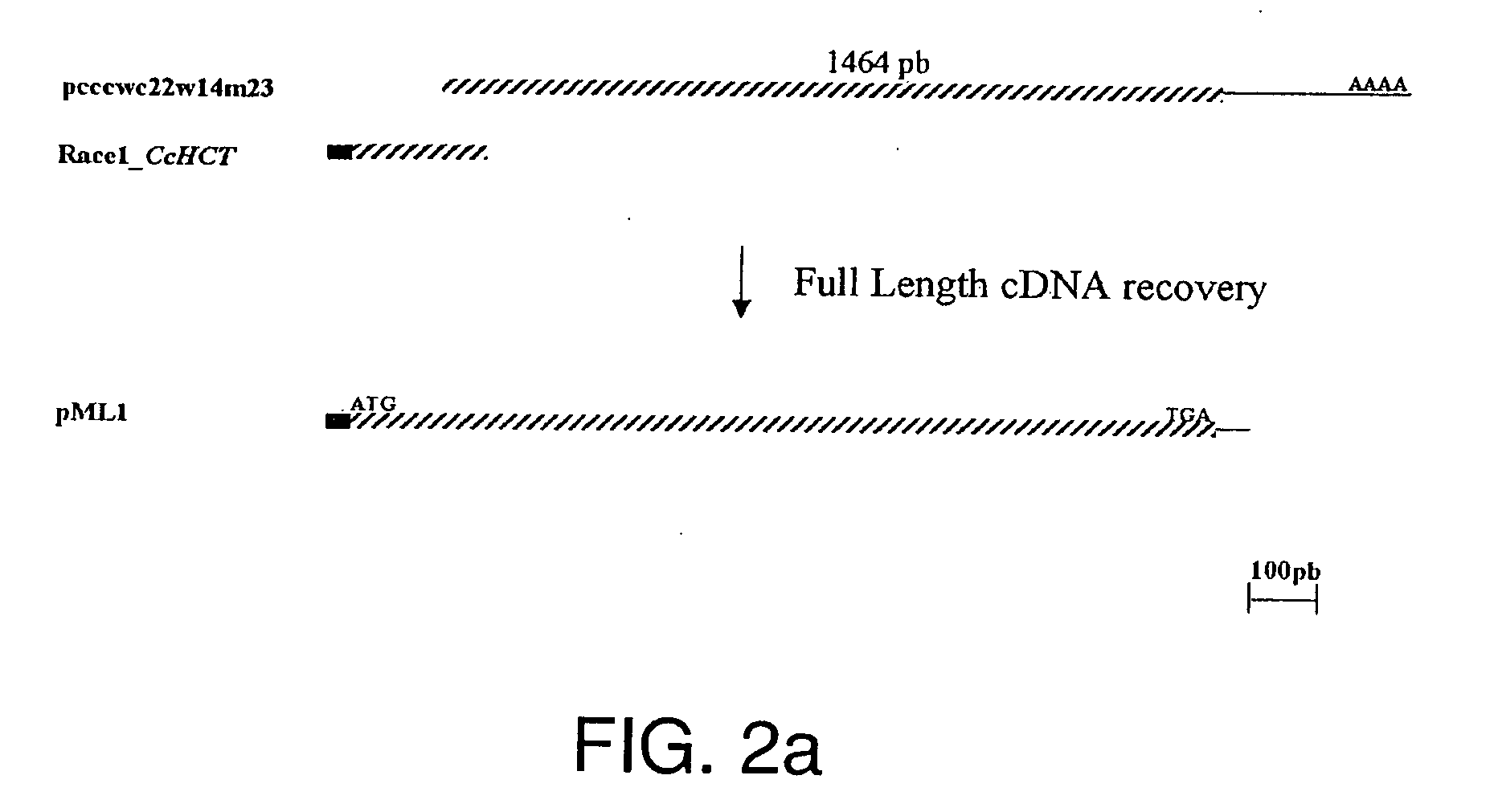Polynucleotides Encoding Phenylpropanoid Pathway Enzymes in Coffee
- Summary
- Abstract
- Description
- Claims
- Application Information
AI Technical Summary
Benefits of technology
Problems solved by technology
Method used
Image
Examples
example 1
Plant Material for RNA Extraction
[0125]Freshly harvested roots, young leaves, stems, flowers and fruit at different stages of development were harvested from Coffea arabica L. cv. Caturra T-2308 and young leaf tissues were harvested from Coffea canephora var. Robusta BP409 grown under greenhouse conditions at Tours (25° C., 70 RH). All other tissues from Coffea canephora BP-409 were grown in the field in East Java, Indonesia. The development stages are defined as follows: small green fruit (SG), large green fruit (LG), yellow fruit (Y) and red fruit (R). Fresh tissues were frozen immediately in liquid nitrogen, then stored at −80° C. until used for RNA extraction.
example 2
Protocols for Extraction of Total RNA, Generation of cDNA, and PCR Reaction Conditions
[0126]To discover the DNA sequences encoding part, or all, of the coffee enzymes HCT (hydroxycinnamoyl-CoA shikimate / quinate hydroxycinnamoyltransferase), HQT (hydroxycinnamoyl-CoA quinate hydroxycinnamoyltransferase), C3H (p-coumaroyl 3′ hydroxylase), and CCoAOMT (caffeoylCoA-3-O-methyltransferase), which control key steps in the synthesis of chlorogenic acids (CGA) in coffee, our coffee unigene sequences with high similarity to public database protein sequences encoding HCT, HQT, C3H, and CCoAOMT from plants such as tomato, tobacco and Arabidopsis were discovered using the TBLASTN algorithm (Altschul et al, 1990). One of the longest cDNA of each unigene with the best hits for each protein sequence were then fully sequenced. If the protein sequence encoded in the longest EST was deemed not to contain the complete ORF, either 5′ RACE PCR or primer assisted genome walking was used to isolate the mis...
example 3
Isolation and Characterization of a Coffea canephora cDNA Clone Encoding Hydroxycinnamoyl-CoA Shikimate / Quinate Hydroxycinnamoyltransferase (CcHCT)
[0140]To find a cDNA encoding the coffee HCT, the Nicotiana tabacum HCT protein sequence (accession number CAD47830 (SEQ ID NO:20)); Hoffmann et al., 2003) served as the query sequence for a BLAST search against the “unigene” set 5 using the tblastn algorithm. The best hit obtained was unigene #123197 (e value=e−150), although a second coffee unigene (#125212) was also found to be highly related to the N. tabacum HCT sequence (e value=e−108). Alignment of the in silico DNA and protein sequences of the unigenes #123197 and #125212 indicated that although they were potentially related, these two unigene sequences encoded different coffee genes.
[0141]A cDNA representing the 5′ end of unigene #123197 (pcccwc22w14 m23) (SEQ ID NO:18), and thus encoding the longest coffee cDNA in the database related to the tobacco HCT, was isolated and sequenc...
PUM
| Property | Measurement | Unit |
|---|---|---|
| Fraction | aaaaa | aaaaa |
| Fraction | aaaaa | aaaaa |
| Fraction | aaaaa | aaaaa |
Abstract
Description
Claims
Application Information
 Login to View More
Login to View More - R&D Engineer
- R&D Manager
- IP Professional
- Industry Leading Data Capabilities
- Powerful AI technology
- Patent DNA Extraction
Browse by: Latest US Patents, China's latest patents, Technical Efficacy Thesaurus, Application Domain, Technology Topic, Popular Technical Reports.
© 2024 PatSnap. All rights reserved.Legal|Privacy policy|Modern Slavery Act Transparency Statement|Sitemap|About US| Contact US: help@patsnap.com










